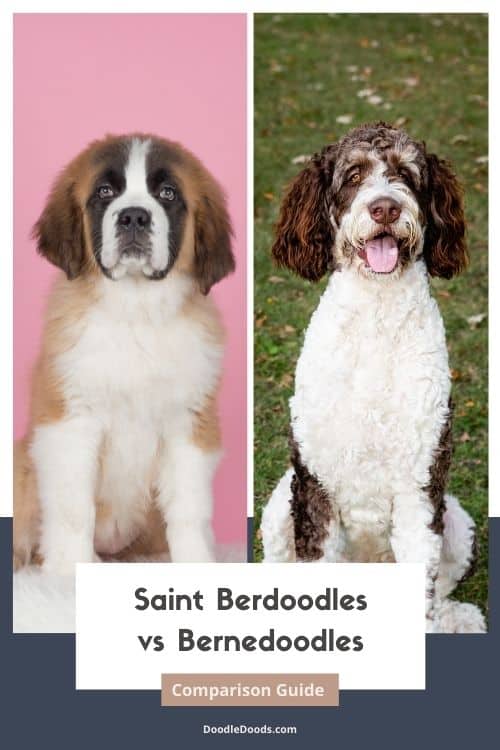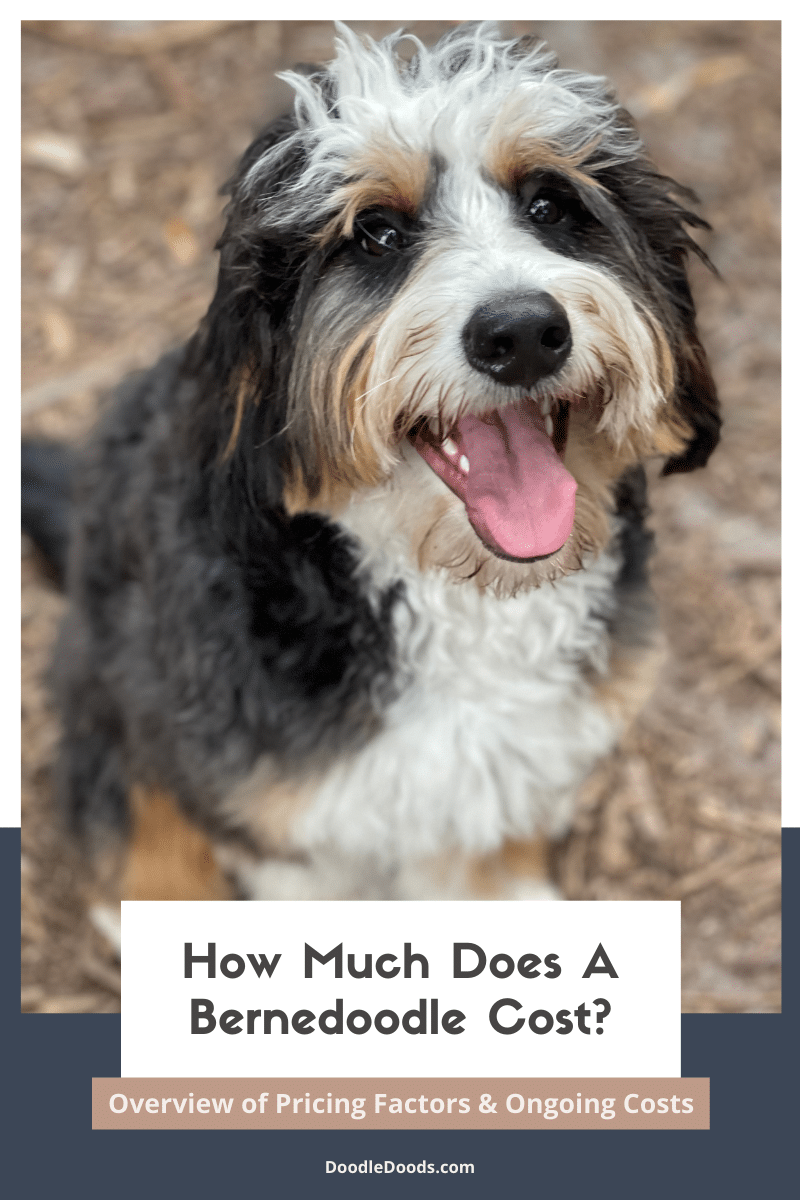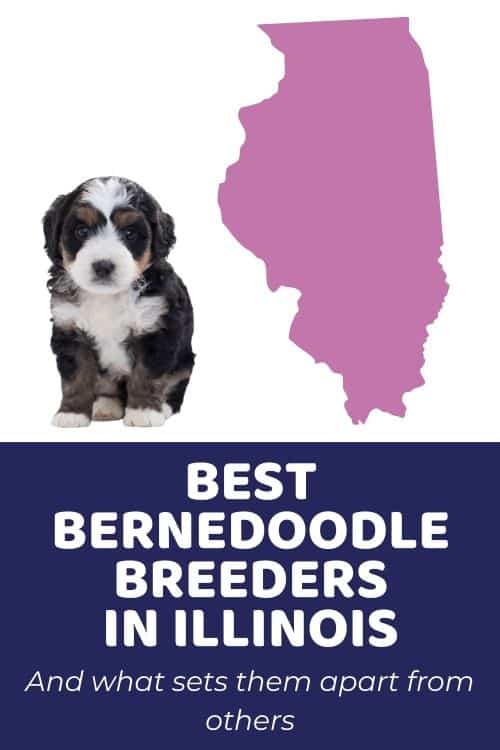Doodle lovers looking for a larger dog may be drawn to the handsome Saint Berdoodle or the equally gorgeous Bernedoodle. However, without much experience with either type (or the breeds that go into their creation), they may be stumped on how best to pick between the Saint Berdoodle vs Bernedoodle. While these dogs may have some startling similarities (beyond just the names, that is), a few crucial differences could tip the balance either way.
While many articles detail the various traits of these dogs in turn, few take the time to compare them like for like. So that was our aim for this particular article. Here we take a look at everything from differences in personality to variations in coat type and color. We then finish with a (hopefully!) helpful rundown of these two similar-looking but definitely distinct Doodles that will make deciding between the two that much easier.
Table of Contents
- All About Saint Berdoodles
- All About Bernedoodles
- Saint Berdoodle vs Bernedoodle: Size
- Saint Berdoodle vs Bernedoodle: Temperament
- Bernedoodle vs Saint Berdoodle: Appearance
- Saint Berdoodle vs Bernedoodle: Grooming & Maintenance
- St Berdoodle vs Bernedoodle: Health & Wellness
- Bernedoodle vs Saint berdoodle: Lifespan
- Saint Berdoodle vs Bernedoodle: Training & Environment
- St Berdoodle vs Bernedoodle: Cost
- Saint Berdoodle vs Bernedoodle: Family Friendliness
- St Berdoodle vs Bernedoodle: Which is the Puppy for You?
All About Saint Berdoodles
St Berdoodles are perhaps one of the lesser established Doodles, yet they are extremely popular among a niche crowd of big dog fans. Their non-Poodle parent, the St Bernard, is classified as a working dog of the giant breed group. Despite being super sociable, chilled canines, the St Bernard’s sheer size perhaps make them a less popular pet choice – that’s a lot of dog to handle! You’re likely already more than familiar with the St B’s rescue dog heritage, but you might not be aware that they make excellent companion animals too.
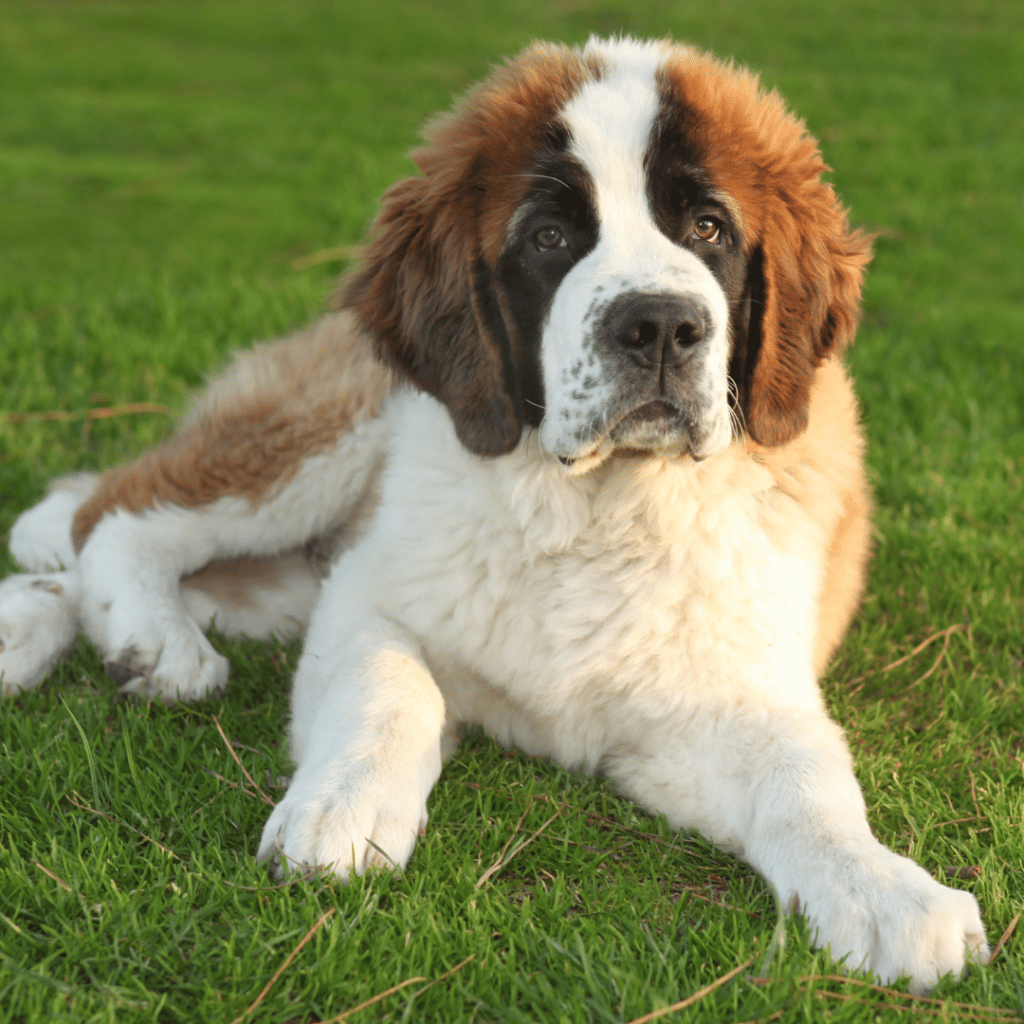
All About Bernedoodles
Bernese Mountain Dogs (the added element of the Bernedoodle) share a similar background story to St Bernard in that they are Swiss mountain-built work dogs. However, these pups were used more for herding and general farm work. Slightly smaller, a touch more delicate, and with a greater range of coat colors than the St B, the Bernese has enjoyed greater popularity as a Doodle parent breed. For this reason, they are far more common. Plus, the Bernedoodle comes in a larger variety of sizes too.
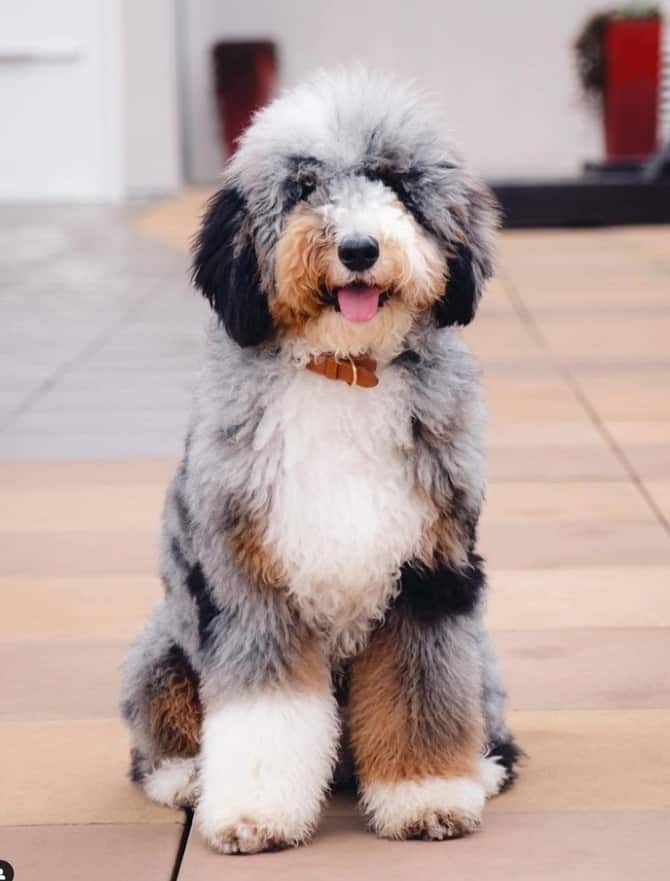
Saint Berdoodle vs Bernedoodle: Size
With the St Bernard being the bigger dog, it’s not surprising that so too is the St Berdoodle – across every size variation of these Doods. That being said, unlike most other Doodles, these dogs aren’t available in the small or toy-sized categories. Given their immense size, it wouldn’t be possible to breed them directly with either of the smaller Poodles, meaning the littler varieties come from smaller-sized St Berdoodle pairings.
While this is a problem when it comes to the Berndoodle too, despite their smaller size, these dogs have been bred longer and much more frequently, so there are more generations. For this reason, and due to their incredible popularity (likely down to their smart shepherd nature and gorgeous tricolored coats), it is possible to get more Toy-sized Bernedoodles. This might be the unique selling point of these dogs for you as it is for so many other slightly larger Doodle fans. All the benefits of a bigger dog in a smaller package.
| St Berdoodle | Bernedoodle | |
| Tiny/Toy | N/A | 10 – 25 pounds 15 inches or less |
| Mini/ Medium | 30 – 55 pounds 14 – 24 inches | 25 – 55 pounds 15 – 22 inches |
| Standard | 55 – 150 pounds 24 – 30 inches | 55 – 90 pounds 23 – 27 inches |
*Height is measured to the shoulder
Saint Berdoodle vs Bernedoodle: Temperament
Both St Berdoodles and Bernedoodles are known to be amiable pups. With the right kind of early socialization, they get along with all manner of people, children, and other animals too. That being said, despite their larger size, they can be a little on the shy side with those they don’t know at first. They also form pretty strong attachments with their family – the St Bernard, with their charming, loving personality, has the edge here – so neither dog does well when left alone for too long. Bernedoodles tend to be a little goofier and more energetic than the quieter, more sensitive St Berdoodle, but both make excellent pets.
Bernedoodle vs Saint Berdoodle: Appearance
Very similar in appearance with their cute fluff-ball coats and those distinctive Doodle teddy-bear looks that come through from the Poodle size, you might be hard-pushed to tell these hounds apart at first glance. This is compounded by the fact that both dogs also tend to be bi or tri-colored. This will usually be a mix of black, tan, and white, with most of the colors being around the eyes, face, and chest area. However, when you look closely, you’ll be able to see that the Bernedoodle is distinctively more fine-boned than the St B, especially when more of the Poodle traits shine through. And while the larger St Berdoodle may look scary, they have teddy bear hearts to match those charming looks of theirs.
Saint Berdoodle vs Bernedoodle: Grooming & Maintenance
Given their shared origins up in the mountains of Switzerland, it’s no surprise that the St Bernard and Bernese Mountain Dogs have very similar hair types. Both dogs were built for keeping warm in a frigid climate with their thick, straight double-layered coats. However, these are a world away from the ‘hypoallergenic’ single-layered, curly Poodle coat. So predicting what kind of coat the offspring of these two hounds may have is tricky, to say the least! Even the experts struggle!
They could inherit any one of the following:
A Straight Coat
This is the St Bernard or Bernese Mountain Dog hair. While generally easier to brush and care for than the tangly Poodle coat, its biggest downside is that it’s far more prone to shedding. This also makes it far less ‘hypoallergenic,’ – bad news for allergy sufferers. However, the Doodle version of this coat tends to stick a little faster to the dog and sometimes may even be single-layered. This can help to keep shedding to an absolute minimum.
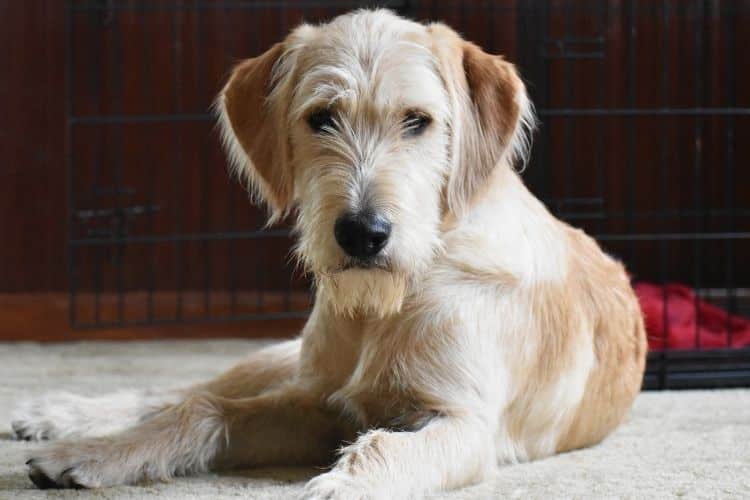
The straight coat type is only usually seen in F1 (one parent of each breed) and F2 (two Doodle parents) dogs. The reason for this is that these puppies have a 50/50 gene split. With other generations, the Doodle offspring is backcrossed with another Poodle to introduce more Poodle genes and get rid of that pesky, thick double, high-shed coat. That means that you also won’t see a straight coat in any of the smaller versions of either of these pups.
A Curly/Wooly Coat
The much-in-demand Poodle coat is great for those allergic to dogs, plus it looks downright darling. Beyond that, it can actually be far more of a headache than most people realize. This is because it’s often quite a nightmare to care for. Loose hair, dirt, dust, and dander get caught up in tight curls forming knots and tangles that, without due care and attention, go on to create matting. This is often the point at which you need to take your pup to the groomer and get them shaved because there’s no hope of removing such tightly formed knots with mere brushing alone.

This coat type is common to F1B, F1BB, F2BB, and F3 dogs as they usually have higher concentrations of Poodle genes than the other kinds.
A Fleecy Coat
Probably the most common of them all – although it can range from more curly to less curly – the fleecy coat sits somewhere between the two extremes. Often long and wavy, this is likely to be the best of the bunch in terms of care. A further benefit is that the fleecy coat is not often double-layered, meaning shedding is much reduced, and waves are less likely to knot than curls (as long as you schedule your pup in for regular trims, that is). You’ll only need to brush a wavy-coated Doodle a couple of times a week to stop them from looking all scruffy and to remove the worst of the dirt.

This coat type can be found across all the different generations.
St Berdoodle vs Bernedoodle: Health & Wellness
As mixed rather than purebred dogs, both Bernedoodles and St Berdoodles benefit from something known as hybrid vigor. The basic premise of this is that their more varied genes make for healthier, happier animals. However, as larger dogs, both the Standard varieties of these Poodle mixes can suffer from some very specific problems that plague their larger parent pups. These include:
- Hip Dysplasia – a condition that results in the loosening of the hip joint and pain when walking. If your dog has this, you’ll notice decreased activity and a swaying, limping gait.
- Wobbler Syndrome – a disease of the neck where the spinal cord is compressed, leading to nervous system deficits, pain in the neck area, and an uncoordinated gait in rear limbs.
- Gastric dilatation-volvulus (GDV) or Bloat – a serious issue where the stomach fills with gas, food, or fluid and subsequently twists. This is a life-threatening condition in dogs.
- Willebrand’s Disease – an inherited bleeding disorder whereby blood fails to clot due to a protein deficiency. vWD is diagnosed with screening as symptoms are difficult to spot.
- Ear Infections – this is a common problem for all Poodles and their offspring. Those warm, hairy ears of theirs are the perfect breeding ground for bacteria and fungus alike.
- Skin Problems – another issue is most often seen in the more sensitive Poodle and some of their offspring. This can be linked to their coat trapping dirt against the skin or allergies.
While the St Berdoodle might have the worst of it due to their larger size, they are still far healthier than St Bernards, who quite often inherit the predisposition for some of these conditions from both their parents rather than just one. This, naturally, makes them more likely to occur.
Bernedoodle vs Saint berdoodle: Lifespan
One of the weirder and sadder aspects of the canine world is that larger dogs (by this, we mean far bigger than your average canine) don’t tend to fair too well in terms of their lifespan as well as their health. The gigantesque Saint Bernard has one of the shortest of these of all dogs, which, unfortunately, they pass along to their offspring. You might expect your St B to last somewhere between 8 to 12 years, with the smaller versions of these hounds being at the top of the scale and the larger ones at the bottom. Bernedoodles, with their smaller size and bigger variation, do better at 12 to 15 years.
Saint Berdoodle vs Bernedoodle: Training & Environment
Despite being the larger of the two, St Berdoodles tend to need a little less exercise than the often slightly more boisterous Bernedoodles. St Bernard’s, like most other giant breeds, can be a little on the lazy side, and this is something they can pass on to their Doodle offspring. It’s good to keep them active, though, as they can quickly start piling on the pounds if you don’t Aim for 30 – 60 minutes of dedicated exercise per day. Bernedoodles, however, may need a little more than this to keep them out of trouble.
The Poodle blood in both mixes blesses these happy hounds with a high level of smarts compared to other canines. They are also reasonably people-pleasing pups. So, in theory, both sides should be easy to train. However, Bernese Mountain Dogs (and so Bernedoodles) can lean towards stubbornness, especially when confronted with a task they’re not so keen to do. You might have to work a little harder to get and hold these dogs’ attention. If you need support with this, Baxter and Bella is a good place to begin.
St Berdoodle vs Bernedoodle: Cost
While a St Berdoodle puppy may set you back around $2,000 on average, when it comes to a Bernedoodle, you’ll likely be looking more in the $3,000 – $4,000 range. Smaller versions of these dogs are typically priced higher, likewise later generations with more Poodle genes. Keep in mind, though, that the ongoing cost of these dogs will likely be less given their smaller size – they won’t eat as much food, require as much coat care, smaller dog accessories are often far cheaper than larger ones, etc. Plus, more mini dogs tend to be a bit healthier than their larger cousins, so you can save on vet bills too.
Saint Berdoodle vs Bernedoodle: Family Friendliness
As portrayed in popular culture (Peter Pan – the Darling’s nurse dogs Nana), the St Bernard is probably one of the best pups for those with children – even very small ones. These dogs are so sweet, gentle, and laid-back that all kids are bound to adore them. While the Poodle genes inject a little more vim and vigor, St Berdoodles still make great and cuddly family pets for those with the space to house them comfortably.
Bernedoodles are plenty easy-going and gentle too, and they just might be a little more exuberant than the lazy St B. For this reason, you might consider a Berndoodle if your kids are a little older and looking for a dog they can run around the garden and play games with. Either way, before taking on a new pet, it’s always best to make a little time to help your kids understand how best to interact with this newest family member.
St Berdoodle vs Bernedoodle: Which is the Puppy for You?
People often are drawn to a type of dog based on the way they look. However, it’s a good idea to think through the various aspects of pup care before making a decision on the dog for you. Various factors will come into play, perhaps most importantly temperament, trainability, and the kind of environment in which each of these hounds thrives.
While the St Berdoodle and Bernedoodle have similar traits from their shared Poodle heritage and the origins of the other parent dogs – which aren’t that dissimilar either, there are some key distinctions between them:
Opt for a Saint Berdoodle if you:
- Are looking for a gentle dog that does well around small children
- Have the space to accommodate a larger pup
- Are happy with dealing with a little more loose hair about the place
- Want a more cuddly couch potato kind of pooch in your life
Choose a Bernedoodle if you:
- Want a pup you can take out on hiking adventures with all the family
- Are looking for a slightly more modestly-sized large dog
- Can dedicate plenty of time to keep your pet busy with exercise, toys, and games
- Have older children that want a dog as a play companion
All dogs are great – aren’t they though? And we may be biased, but we think Doodles are the best of the bunch. However, when it comes to dog ownership, everyone has their preferences. While littler dogs tend to be a bit more popular as they are perceived as more manageable, there are plenty of big dog fans around too. If that’s you and you’re looking to select between two of the more giant Doodles around – the St Berdoodle and the Bernedoodle, then you have come to the right place. Hopefully, the details given in this article comparing these two same, same yet different dogs can help you make the right choice for you and your family.

